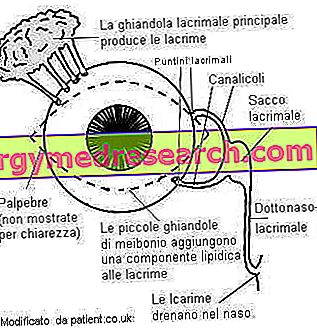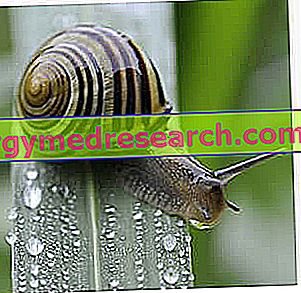Tears and lacrimal apparatus
Tears are liquid secretions that constantly coat the conjunctival surfaces, keeping them moist and protected. Their presence reduces friction, obstructs bacterial invasions, provides nourishment and oxygen to the conjunctival epithelium and removes toxic substances or small foreign bodies in or around the eyes. Even the eyelids, which represent the continuation of the skin, have a fundamental role in protecting the eyes: in addition to providing a mechanical barrier, their intermittent movements distribute tears over the entire surface of the eye, keeping it lubricated and free from dust and others particles.

Lacrimum disorders are the result of alterations in the physiological process of tear production and outflow. Causes include an increased secretion from the lacrimal gland (hyper-magnification) or inadequate drainage of the tear ducts (epiphora). The alteration of the tear film may be caused by a disorder affecting the ocular structures or may represent a clinical sign of a systemic disease, such as Sjögren's syndrome.
Causes
Excessive or persistent tearing is an ocular clinical sign caused by various conditions. The qualitative-quantitative alteration of the tear film, for example, can occur following pathologies such as conjunctivitis, conformational changes of the eyelid margin, lesions to the eye or other conditions that hinder the outflow of tears.
The two main causes responsible for an altered watering are:
- Clogged tear ducts . The most common cause of insufficient drainage of tears between adults is due to partial or complete stenosis (narrowing) of the tear ducts. If these are restricted or blocked, tears cannot flow out, they accumulate in the lacrimal sac and become the cause of swelling (inflammation). Stagnation of tear fluid increases the risk of infection in the area and the eye reacts by producing a sticky secretion, further aggravating the problem. Furthermore, a defect of the lacrimal glands can induce the secretion of an insufficient tear volume or of altered composition. The effect causes dry eyes, which become more vulnerable to irritation and may not be able to adequately fight infections.
- Excessive production of tears. Any irritative or inflammatory stimulation of the ocular surface (infections, allergies, foreign bodies or other irritating substances) can induce the reflexive tearing of the eyes; it is an innate defensive mechanism to eliminate the irritating causes and protect the eye.
Lacrimum disorders can occur at any age, but are more common in young children (0-12 months) and in people over the age of 60. The alteration of the tear film can affect one or both eyes and can cause blurred vision, edema of the eyelids and crusting.
Babies
Sometimes, it is possible to observe that the eyes of newborns are unusually full of tears. The most common cause of persistent neonatal tearing is the presence of a blocked or not completely patent tear duct. In fact, it may take a few weeks before the nasolacrimal canal opens. Within a few months, however, the condition resolves spontaneously with the complete development of the anatomical structures involved.
The pathology that determines the lack or delayed development of the lacrimal ducts is called congenital dacriostenosis (it affects about 30% of children). This is manifested by uncontrolled lacrimation, palpebral edema and pus secretion (after squeezing the lacrimal sac). Congenital dacriostenosis sometimes requires the intervention of a specialist, who can perform a microsurgical procedure to open the tear ducts with a probe. The use of antibiotics and local massage in the region of the lacrimal sac may be useful.
children
In children, the most common causes of excessive tear secretion are allergies and viral conjunctivitis.
Adults
Lacrimum disorders are often the result of the aging process. The elderly sometimes have a blocked tear duct. More commonly, in these patients the muscles that keep the inner part of the eyelid stretched out against the eyeball are relaxed, leaving dry areas that become painful and chronically irritated. Furthermore, the tears of some subjects have a high lipid content and this phenomenon can also interfere with the diffusion of the tear fluid on the surface of the eye, which is irritated and produces hyper-tear.
The following conditions can cause excessive tear production:
- Irritation of the cornea (anterior part of the eye);
- Blepharitis (inflammation of the eyelid margins);
- Infectious conjunctivitis;
- Cold;
- Rhinitis;
- Dry eye syndrome (hyperlacration is the body's natural response to too dry eyes);
- Ectropion (eyelid facing outwards);
- Entropion (eyelid facing inward);
- Some chemical substances dispersed in the air;
- Environmental irritants: smog, wind, lights, sand and dust;
- Foreign bodies between eyelid and eyeball;
- Allergic reaction to mold, hair, pollen and other allergens;
- Infection of the lacrimal sac (dacryocystitis);
- Ingrown eyelashes (trichiasis);
- Trachoma.
Less commonly, tear disorders can result from:
- Eye injuries, such as a scratch or abrasion;
- Congiuntivocalasi;
- Chronic sinusitis;
- Congenital or early-onset glaucoma in newborns;
- Flaccid eyelid syndrome (palpebral ptosis);
- Other inflammatory diseases of the eye (such as uveitis, keratitis and scleritis);
- Rheumatoid arthritis;
- Sarcoidosis;
- Paralysis of the seventh facial nerve (damage to a nerve);
- Sj ö gren syndrome (due to dry mouth and eyes);
- Stevens-Johnson syndrome;
- Eye or nose surgery: poor reconstruction of the nasolacrimal duct system after facial trauma (fractures of LeFort, nose-ethmoid or maxillary) and soft tissue (nose and / or eyelid);
- Thyroid diseases;
- Tumors affecting the lacrimal drainage system;
- Wegener's granulomatosis.
Medications that can cause tears include:
- Epinephrine;
- Chemotherapy drugs;
- Cholinergic agonists;
- Type 5 phosphodiesterase inhibitors, specific for cGMP (sildenafil, avanafil, tadalafil, vardenafil)
- Some eye drops, especially phospholine iodide and pilocarpine.
Other symptoms that may accompany tear disorders include:
- Burning eyes and feeling of the presence of a foreign body;
- Itchy eyes;
- Reduction of visual acuity;
- photophobia;
- Eyelid edema;
- Redness of the eyes and hyperemia (increase in blood) of the conjunctiva;
- Pain, especially if a trauma has occurred;
- Purulent eye discharge and crusting around the eyes.
Diagnosis
The diagnosis is based on the careful observation of the anatomical structures involved, on some simple tests and on the collection of information related to the clinical presentation. Once the cause of the anomalous tearing has been identified, the most appropriate therapeutic strategy for the individual case can be defined.
First, the doctor will probably check to see if the patient is suffering from dry eyes; one of the most common causes of excessive tearing, in fact, is precisely dry eye syndrome: tear dysfunction causes eye discomfort and triggers the body's reflex to produce too many tears. If the disorder results from dry eyes or from an irritative phenomenon, the use of artificial tears four or five times a day or the application of warm compresses over the eyes for several minutes may be useful.
If necessary, your doctor may refer you to an ophthalmologist for further examination. One of the main diagnostic tests is washing of the tear ducts, used to check for obstruction in the tear ducts. After the administration of a local anesthetic, useful to reduce discomfort, the ophthalmologist inserts a thin probe through the opening of one of the lacrimal channels in the inner corner of the eyelids (lacrimal dots). A sterile solution is then injected and the patient indicates if he perceives the flow of the liquid in the throat. Through the cannula, a fluorescein-based tincture can also be injected to examine the puncture reflux by pressing on the tear channels and noticing any resistance. If the tear ducts are patent, the cause of the anomalous tear production must be sought elsewhere.
Although a tear disorder does not represent an emergency situation, it is necessary to contact the doctor immediately when he / she is accompanied by:
- Reduced vision;
- Pain, bleeding or swelling around the eyes;
- Hardened and reddened skin above the lacrimal sac;
- Swelling around the nose or paranasal sinuses;
- Purulent secretions;
- Eye contact with a chemical;
- Severe eye injury (scratch, abrasion or penetration of a foreign body).
Each of these symptoms indicates a more serious problem.
Treatment
The therapy of tearing disorders depends on how serious the problem is and the causes that cause it.
- If the cause of excessive lacrimation corresponds to an irritative stimulus, a medical therapy aimed at removing the source that causes the debacle will be decisive in most cases. For example, if an eyelash grows towards the inside of an eye (trichiasis) the doctor can proceed with its removal; in the case of qualitative alteration of the tear fluid it is instead indicated the regular use of substances that protect the ocular surface. Artificial tears can help to moisten the eyes again, if they are dry or burn. If the lower eyelid is facing inward (entropion) or outward (ectropion), surgery can be recommended on the tendon which keeps the eyelid in place. In the case of bacterial infection (bacterial conjunctivitis), the doctor may prescribe a course of antibiotics, while an antihistamine helps reduce the inflammation associated with an allergic reaction.
- If the cause of tearing disorders is the narrowing or obstruction of tear ducts, surgery may be required to eliminate the problem. In fact, a series of microsurgical procedures are able to resolve the blockage or create an alternative pathway to bypass the obstruction and drain tears (dacryocystorhinostomy). If the tear duct is not blocked, but only reduced, a balloon catheter can be used to enlarge it.
dacryocystorhinostomy
Obstruction of a tear duct can be treated with a microsurgical procedure called dacryocystorhinostomy (DCR). This intervention is indicated if the symptoms are particularly severe and the tearing of the eyes interferes with vision while driving, reading and sports. Obstruction of neglected tear ducts may facilitate the onset of acute or chronic infections due to stagnation of tears (such as dacryocystitis). If the patient has an infection in the lacrimal sac, he must be treated with antibiotics before surgery. If left untreated, the infection can spread to the eye socket.
Through the operation of dacryocystorhinostomy, the surgeon creates a new lacrimal canal to restore drainage, allowing the physiological passage of tears which thus bypass the obstructed part of the nasolacrimal duct. In general, surgery involves removing a small piece of bone from the side of the nose to allow communication between the lacrimal sac and the nasal cavity. The procedure can be performed externally (by making a small skin incision on the side of the nose) or by using an endoscope (from the inside of the nose). A very thin silicone tube is generally inserted to maintain the patency of the canal. After a couple of months, the cannula is removed. Dacryocystorhinostomy is usually performed under general anesthesia and takes up to an hour to perform.



